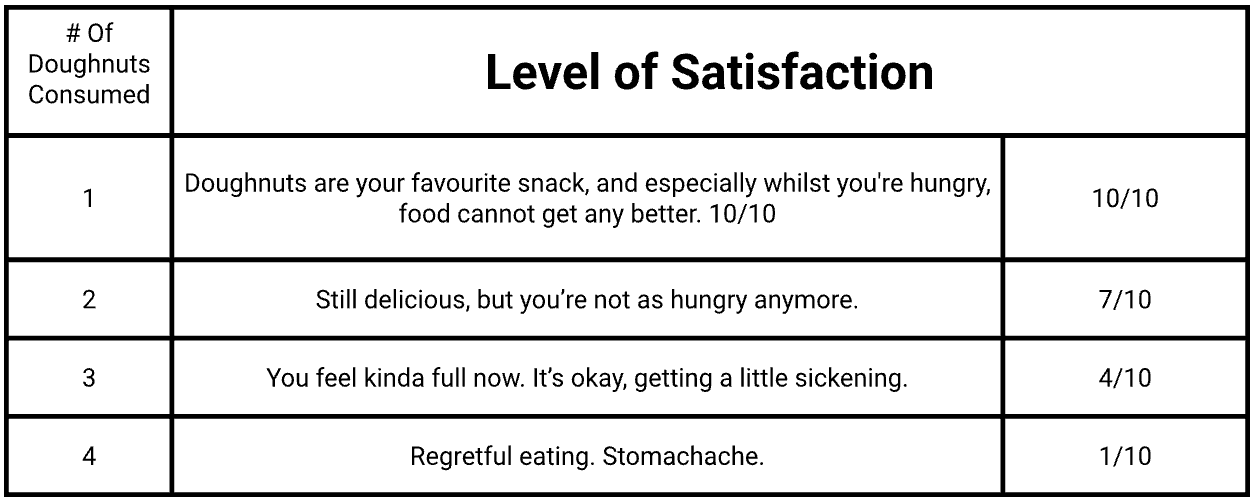Why More Isn’t Always Better
By Samyukta Pai
Have you ever eaten a doughnut, and then another, and then one more, until suddenly you instantly feel regretful, thinking, “Why did I eat that last doughnut?”. Well, that, right there, is a clear-cut case of the law of diminishing marginal utility.
Although it may sound extremely daunting to someone who is new to economics, this concept simply means:
“As we consume more of an item, the amount of satisfaction produced by each additional unit of that good declines.” – The Economic Times
Let's run back to that doughnut scenario, shall we? This table represents our satisfaction with each doughnut as we progress through a half dozen with a table:
Figure 1: Table of Satisfaction
This evident decline in your levels of satisfaction can be attributed to the law of diminishing marginal utility. In simpler words, the word marginal refers to “the next one”. And the word utility refers to how much use you can get out of something.
Why does this matter?
Let's move beyond doughnuts and take the NFL, for example.
In 2016, the NFL saw a steep 8% drop in viewership, confusing fans and analysts as to how one of America's most beloved sports could experience such a sharp decline.
This phenomenon is explained by the law of marginal utility. Over the years, the NFL expanded its schedule to Sunday games (afternoon and night), Monday night football, Thursday night football, and occasional Saturday games and international matches. Sounds like a lot, right? It's because it is: football fans have nearly daily access to watching football from the comfort of their TV’s.
This overwhelming screen time of football games led to a plethora of accidental negative consequences, such as:
Viewer fatigue as fans felt overwhelmed by the amount of content.
Decreased anticipation as each game was readily available and thus less special.
Lower ratings since added games provided less enjoyment, so fans chose to skip them.
This demonstrates the law of diminishing marginal utility, as with every additional use of the good, in this case, a football game, the added satisfaction from each additional game decreases.
We can see this all over our real lives, from school events to even our favourite songs. The law of diminishing marginal utility is a universal concept that can be applied to many logistical and emotional human experiences.
Economists, for example, use this law to explain why people may not spend as much on the second or third item from a given firm, how businesses decide prices (like discounts and deals: “buy one, get one 50% off”), and why the value of a good may drop the more we consume it. Due to this law, the demand curve actually slopes downward, as people demand less of something when the price goes up, and as they get more of it.
Lastly, although it may not seem like it at first, this economic concept is particularly important. It teaches us that happiness is not unlimited, and satisfaction has its restrictions. Mass quantities do not necessarily equate greater value; rather, the opposite. Making good decisions often also means knowing when to stop. This concept may be particularly helpful for adults who budget their money.
So, next time you feel your satisfaction waning after eating more of your favourite food, remember that it's not YOU, it's the law of diminishing marginal utility.
Glossary
The Law of Diminishing Marginal Utility: As a consumer increases their consumption of a good or service, the marginal utility (additional satisfaction) they derive from each additional unit will eventually decrease.
Consumption: The use of goods and services by households.
Marginal: Refers to “the next one” or the additional unit of something.
Utility (satisfaction): The level of satisfaction or usefulness gained from consuming a good or service.
Demand: How much of a product buyers want to purchase at different prices.
Pricing Strategy: How businesses set prices based on consumer behaviour and demand.


